Science & Environment
Neil deGrasse Tyson takes readers on a cosmic journey with “Merlin”

Watch CBS News
Be the first to know
Get browser notifications for breaking news, live events, and exclusive reporting.
Science & Environment
Alarm call as world’s trees slide towards extinction
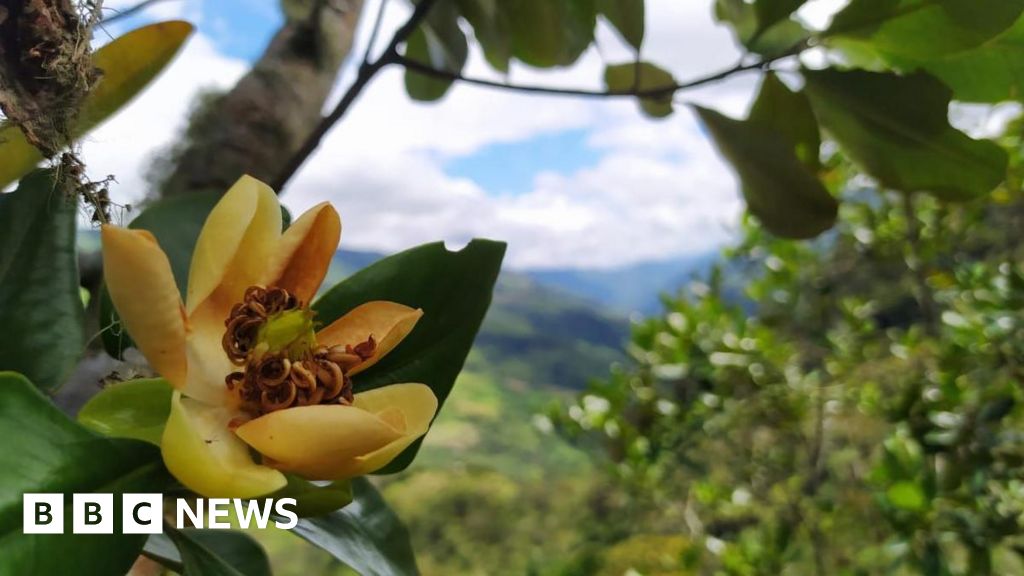
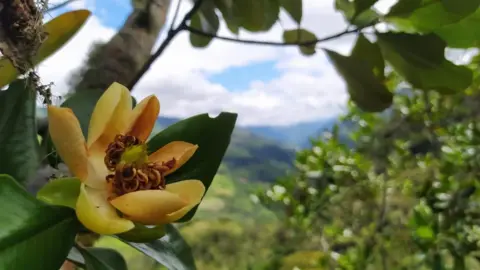 Salvamontes Colombia
Salvamontes ColombiaScientists assessing dangers posed to the world’s trees have revealed that more than a third of species are facing extinction in the wild.
The number of threatened trees now outweighs all threatened birds, mammals, reptiles and amphibians put together, according to the latest update to the official extinction red list.
The news was released in Cali, Colombia, where world leaders are meeting at the UN biodiversity summit, COP 16, to assess progress on a landmark rescue plan for nature.
Trees are vital for life, helping to clean the air and soak up carbon emissions, as well as providing homes for thousands of birds, insects and mammals.
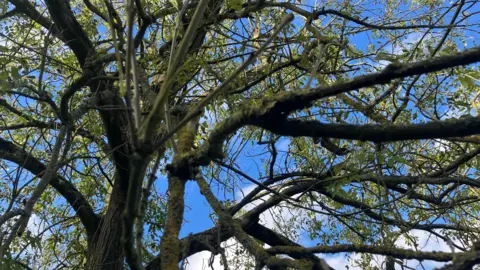
More than 1,000 scientists took part in the assessment of the conservation status of trees, compiled by the plant conservation charity, Botanic Gardens Conservation International (BGCI) and the International Union for Conservation of Nature (IUCN).
Emily Beech of BGCI said 38% of the world’s trees are now threatened with extinction.
“Trees are highly threatened all across the world but now we have the tools that we need to make sure that we prioritise conservation action on the ground,” she said.
Trees are at risk in 192 countries, with clearing land for farming and logging the biggest threat and, in temperate regions, pests and diseases.
Well-known trees such as magnolias are among the most threatened, with oaks, maple and ebonies also at risk.
 Getty Images
Getty ImagesScientists at the Royal Botanic Gardens, Kew, in London, are working to conserve trees across the world by collecting seeds and growing specimens in arboretums.
Conservation researcher Steven Bachman said the figures were “shocking”, with a knock-on effect for the many other plants and animals that depend on trees.
“We are currently in a biodiversity crisis,” he said. “Many species of trees all around the world are providing habitat for many other species of birds, mammals, insects, fungi.
“If we lose the trees we are losing many other species with them.”
 Getty Images
Getty ImagesAs well as trees, the update to the extinction red list brought bad news for other plants and animals.
The hedgehog (Erinaceus europaeus) moved a step closer to extinction as populations shrink across much of Europe, including the UK.
The much-loved mammal is losing its natural habitat due to the expansion of farming and land development.
There are also concerns for the survival of migratory birds, many of which make stop-offs on Britain’s vast shorelines and estuaries.
Four UK shorebirds – the grey plover, dunlin, turnstone and curlew sandpiper – are becoming more endangered on the red list.
 RSPB Titchwell
RSPB TitchwellAt COP 16, world leaders are meeting to take stock of progress in meeting a pledge of protecting 30% of lands, seas and oceans by 2030.
The summit is due to end on 1 November, with many issues still outstanding, including finance for preserving biodiversity across the globe and beefing up national plans for protecting nature.
 Getty Images
Getty ImagesScience & Environment
No other sector has more on the line in this election than energy. How to play it
Science & Environment
World falling “miles short’ of emissions goals to curb climate change, U.N. says, sounding the alarm

Paris — Greenhouse gas concentrations in the atmosphere reached record highs in 2023, the United Nations warned on Monday, saying countries are falling “miles short” of what’s needed to curb devastating global warming.
Levels of the three main greenhouse gases — heat-trapping carbon dioxide, methane and nitrous oxide — all increased yet again last year, said the World Meteorological Organization, the U.N.’s weather and climate agency.
Carbon dioxide was accumulating in the atmosphere faster than ever, up more than 10 percent in two decades, it added.
And a separate U.N. report found that barely a dent is being made in the 43 percent emissions cut needed by 2030 to avert the worst of global warming.
Action as it stands would only lead to a 2.6 percent reduction this decade from 2019 levels.
“The report’s findings are stark but not surprising — current national climate plans fall miles short of what’s needed to stop global heating from crippling every economy and wrecking billions of lives and livelihoods across every country,” said U.N. climate chief Simon Stiell.
The two reports come just weeks before the United Nations COP29 climate summit in Azerbaijan and as nations prepare to submit updated national climate plans in early 2025.
“Bolder” plans to slash the pollution that drives warming will now have to be drawn up, Stiell said, calling for the end of “the era of inadequacy.”
Under the 2015 Paris Agreement, countries said they would cap global warming at “well below” two degrees Celsius above average levels measured between 1850 and 1900 — and 1.5C if possible.
But so far, their actions have failed to meet that challenge.
Existing national commitments would see 51.5 billion tons of CO2 and its equivalent in other greenhouse gases emitted in 2030 — levels that would “guarantee a human and economic trainwreck for every country, without exception,” Stiell said.
As long as emissions continue, greenhouse gases will keep accumulating in the atmosphere, raising global temperatures, WMO said.
Last year, global temperatures on land and sea were the highest in records dating as far back as 1850, it added.
WMO chief Celeste Saulo said the world was “clearly off track” to meet the Paris Agreement goal, adding that record greenhouse gas concentrations “should set alarm bells ringing among decision-makers.”
“CO2 is accumulating in the atmosphere faster than at any time during human existence,” the report said, adding that the current atmospheric CO2 level was 51 percent above that of the pre-industrial era.
The last time the Earth experienced a comparable concentration of CO2 was three to five million years ago, when the temperature was two to three degrees Centigrade warmer and the sea level was 65 feet higher than now, it said.
Given how long CO2 lasts in the atmosphere, current temperature levels will continue for decades, even if emissions rapidly shrink to net zero.
In 2023, CO2 concentrations were at 420 parts per million (ppm), methane at 1,934 parts per billion, and nitrous oxide at 336 parts per billion.
CO2 accounts for about 64 percent of the warming effect on the climate.
Its annual increase of 2.3 ppm marked the 12th consecutive year with an increase greater than two ppm — a streak caused by “historically large fossil fuel CO2 emissions in the 2010s and 2020s,” the report said.
Just under half of CO2 emissions remain in the atmosphere, while the rest are absorbed by the ocean and land ecosystems.
Climate change itself could soon “cause ecosystems to become larger sources of greenhouse gases,” WMO deputy chief Ko Barret warned.
“Wildfires could release more carbon emissions into the atmosphere, whilst the warmer ocean might absorb less CO2. Consequently, more CO2 could stay in the atmosphere to accelerate global warming.
Science & Environment
World way off target to limit warming says UN

 Getty Images
Getty ImagesGlobal efforts to tackle climate change are wildly off track, says the UN, as new data shows that warming gases are accumulating faster than at any time in human existence.
Current national plans to limit carbon emissions would barely cut pollution by 2030, the UN analysis shows, leaving efforts to keep warming under 1.5C this century in tatters.
The update comes as a separate report shows that greenhouse gases have risen by over 11% in the last two decades, with atmospheric concentrations surging in 2023.
Researchers are also worried that forests are losing their ability to soak up carbon, which could be contributing to record levels of warming gas in the atmosphere.
 Getty Images
Getty ImagesUN Climate Change, the UN agency tasked with adressing the issue, has carried out an analysis on the carbon cutting plans that have been submitted by close to 200 countries.
The UN wants to see how much progress is being made in driving down emissions that are threatening to push global temperatures well above 1.5C this century, a level beyond which scientists say extremely damaging impacts will occur.
Right now, when the plans are added up, they indicate that emissions will likely fall by just 2.6% by 2030 compared to 2019.
This is far short of the 43% reduction that scientists say will be needed by the end of this decade to keep the world on track for net-zero carbon by 2050.
“The report’s findings are stark but not surprising,” said Simon Stiell, executive secretary of UN Climate Change.
“Current national climate plans fall miles short of what’s needed to stop global heating from crippling every economy, and wrecking billions of lives and livelihoods across every country.”
The UN says that countries are expected to submit new, stronger plans by Spring next year – discussions about increasing the ambition of these efforts will be a major theme when world leaders gather at the next UN climate conference, COP29 in Azerbaijan next month.
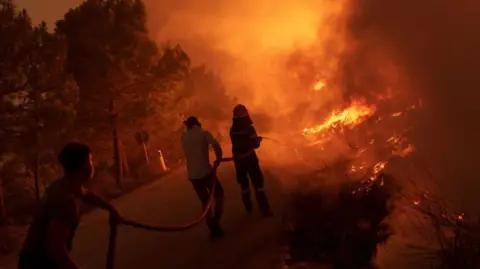 Getty Images
Getty ImagesForest feedback loop
Adding to the concerns about the way the world is handling climate change, the World Meteorological Organisation says that concentrations of greenhouse gases reached a record high in 2023.
The rise last year was higher than the previous 12 months, due to record fires in Canada, and the onset of the El Niño weather event all adding to ongoing emissions from fossil fuels.
But the WMO’s scientists also says they have seen some evidence that as the world gets warmer, trees are not able to soak up the same level of CO2 as they once were.
Data indicates that the southeastern Amazon has now turned from a carbon sink to a source.
“In the Amazon, deforestation means you lose the forest,” said Dr Oksana Tarasova from the WMO.
“Then the temperature started increasing, then the air circulation pattern changes. There is less precipitation, less uptake of CO2, that means more CO2 stays in the atmosphere.”
The Amazon is one example of what scientists call a climate feedback – where rising temperatures can act on natural systems to enhance the causes of warming.
So if the forests and the oceans become less able to soak up CO2, global warming could accelerate more rapidly.
“We do see some clear signals. We cannot say it’s 100% climate feedbacks because there’s substantial variability because of El Niño and La Niña weather events, but we are seeing something happening in the system,” said Oksana Tarasova.
The WMO says that the last time the Earth experienced a comparable concentration of carbon in the atmosphere was 3-5 million year ago – when average temperatures were 2-3C warmer than they are now, and sea levels were 10-20 metres higher.
Science & Environment
Nasdaq hits high even amid poor earnings growth
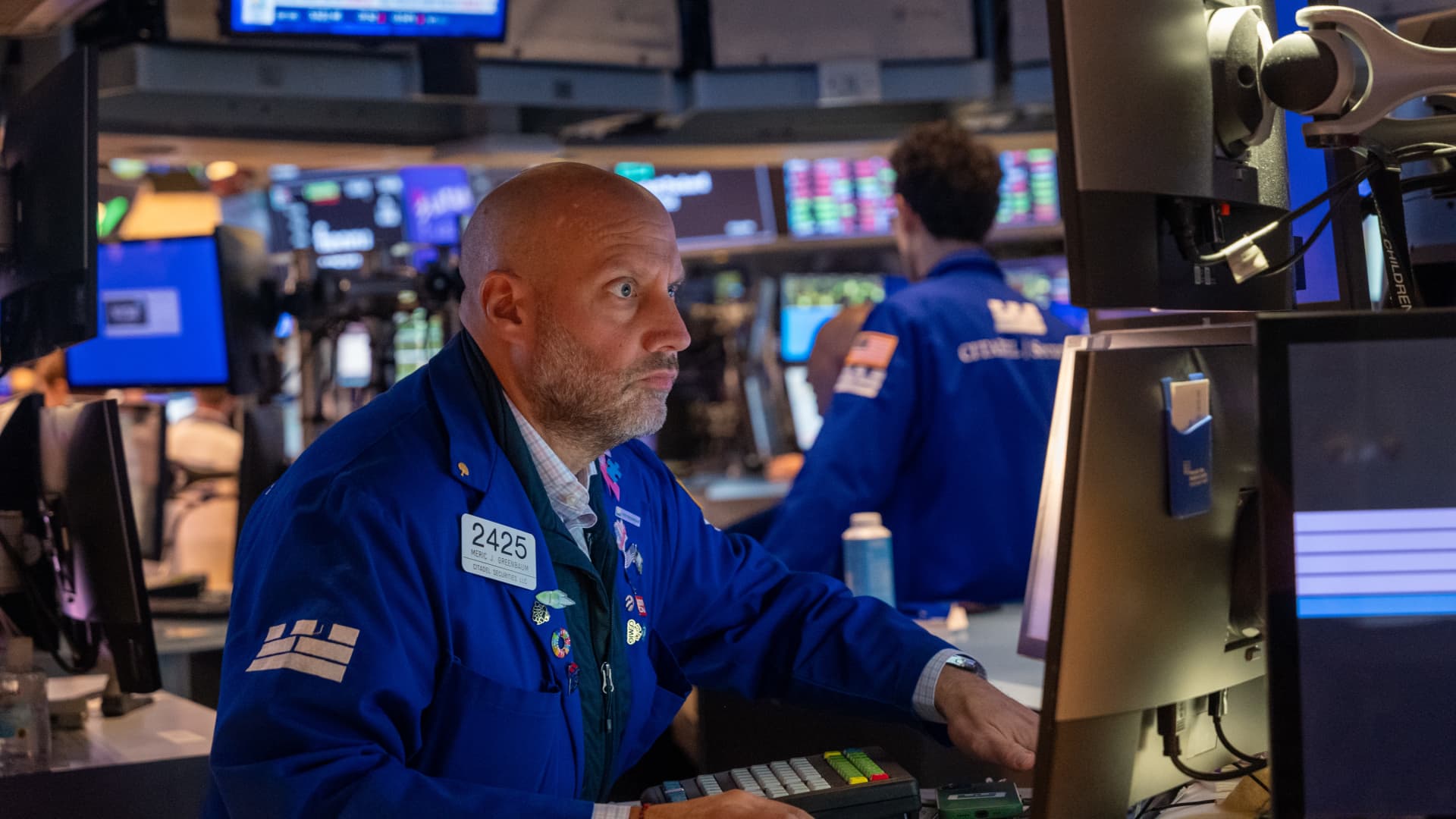
Traders work on the floor of the New York Stock Exchange (NYSE) on October 22, 2024 in New York City.
Spencer Platt | Getty Images
This report is from today’s CNBC Daily Open, our international markets newsletter. CNBC Daily Open brings investors up to speed on everything they need to know, no matter where they are. Like what you see? You can subscribe here.
What you need to know today
New high for Nasdaq
On Friday, the Nasdaq Composite hit an all-time high, but the S&P 500 and Dow Jones Industrial Average fell and snapped their six-week winning streaks. Asia-Pacific markets traded mixed Monday. Japan’s Nikkei 225 jumped about 1.8% and the yen weakened to a three-month low against the dollar on the back of the country’s election results.
Steepest drop since pandemic
China’s industrial profits in September slumped 27.1% from a year ago, according to the country’s National Bureau of Statistics. That’s the steepest drop since the start of the pandemic in March 2020, based on data from Wind Information – which excludes statistics from most of 2022 when China was under strict zero-Covid policies.
Oil prices dropped on ‘limited damage’
Prices for both Brent and West Texas Intermediate oil futures dropped more than 4% on Monday. This comes after Iranian media described Israel’s strikes over the weekend on its military installations as causing “limited damage.” Citi lowered its forecast for Brent oil prices by $4 to $70 per barrel over the next three months.
Japan’s ruling coalition loses parliamentary majority
Japan’s Liberal Democratic Party and its Komeito partner will lose their parliamentary majority, according to projections from public broadcaster NHK and publication Nikkei Asia, while the opposition camp made significant gains. The Japanese yen fell against the U.S. dollar on the political uncertainty.
[PRO] Very, very busy week for markets
This week is jam-packed with important earnings and economic data. Five of the Magnificent Seven companies report earnings. The personal consumption expenditures index report for September and the key jobs report for October will also be released this week.
The bottom line
The Nasdaq Composite managed to log a seventh consecutive winning week.
After adding 0.56% on Friday, the index closed at an all-time high, ending the week 0.2% higher.
Other major U.S. indexes, however, didn’t do so well. Both the S&P 500 and Dow Jones Industrial Average shattered their six-week positive streak following their falls on Friday.
The tech-heavy Nasdaq was boosted by Tesla’s monster rally. Investors also looked ahead to Big Tech earnings coming out this week: shares of Meta, Amazon and Microsoft added as much as 1%.
Earnings season has been a mixed bag so far. Even though almost three-quarters of S&P companies have beaten expectations, according to FactSet data, the rate of profit growth has not met expectations, disappointing investors.
Tesla had a monster rally over two days last week, which helped it regain all its losses for the year. But more than half of the 20-largest companies saw their stocks fall after they announced their financials last week, notes CNBC’s Pia Singh.
As those companies were mostly from sectors outside tech, their losses dragged down the S&P and the Dow, especially, since a good proportion were constituents of the 30-stock index. In fact, around 90% of Dow members ended the week in the red.
For instance, Coca-Cola surpassed Wall Street’s estimates of its earnings and revenue, but its shares still fell. Investors were perhaps disappointed by news that consumers are buying fewer packs of Coke products, as CEO James Quincey said during the post-earnings conference call, and troubled by the headwinds that the company thinks will hamper its growth in 2025.
With five of the Magnificent Seven companies reporting earnings and crucial economic data coming out this week, investors will hope all the numbers line up for a payout – if not of the jackpot magnitude, then at least one that jolts the S&P and Dow back into the green again.
— CNBC’s Brian Evans, Pia Singh and Alex Harring contributed to this report.
Science & Environment
Foreign investors flock to flagship Saudi economic conference
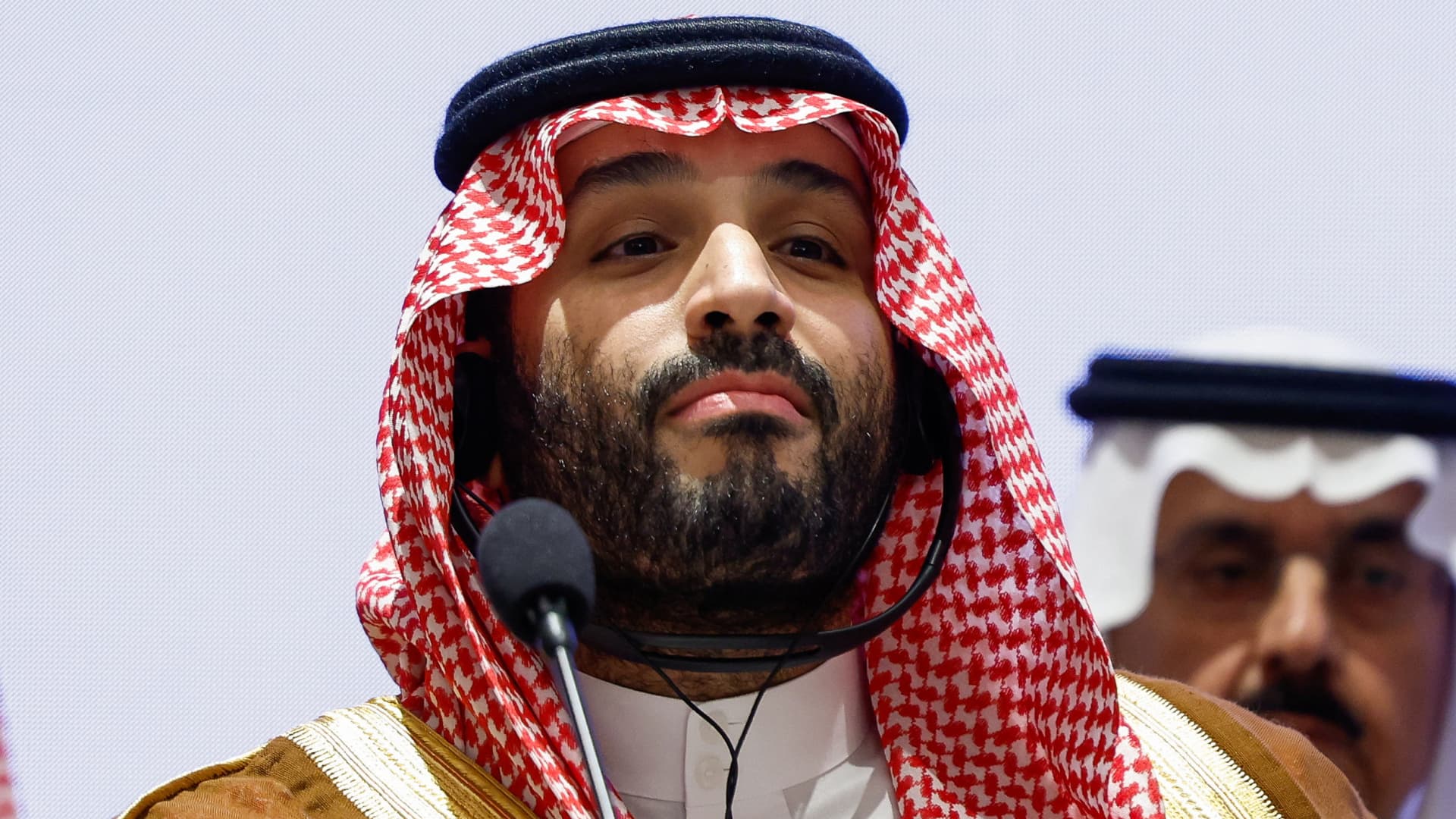
A delegate arrives at the King Abdulaziz Conference Centre in Saudi Arabia’s capital Riyadh to attend the Future Investment Initiative (FII) forum on October 29, 2019. – Top finance moguls and political leaders were expected at a Davos-style Saudi investment summit in stark contrast to last year when outrage over critic Jamal Khashoggi’s murder sparked a mass boycott. Organisers say 300 speakers from over 30 countries, including American officials and heads of global banks and major sovereign wealth funds, are attending the three-day forum. (Photo by FAYEZ NURELDINE / AFP) (Photo by FAYEZ NURELDINE/AFP via Getty Images)
Fayez Nureldine | Afp | Getty Images
Thousands of financiers, founders and investors are set to descend on the Saudi capital of Riyadh for the eighth edition of the kingdom’s Future Investment Initiative, the flagship economic conference at the heart of Vision 2030 — the multi-trillion dollar plan to modernize and diversify Saudi Arabia’s economy.
Described in past years by some attendees as a bonanza for Saudi cash, fund managers who spoke to CNBC this year draw a distinctly different picture as the kingdom simultaneously upholds more requirements for prospective fundraisers and investors, while also facing a revenue crunch amid lower oil prices and production.
“Without question, it’s gotten way more competitive to attract money from the kingdom,” Omar Yacoub, a partner at U.S.-based investment firm ABS Global, which manages nearly $8 billion in assets, told CNBC. “Everyone and anyone has been going to ‘kiss the rings,’ so to speak, in Riyadh.”
“Competition for capital has heated up, combined with other factors such as Saudis always having a ‘home bias’ towards investing, plus the broader dynamic of a tighter budget throughout the kingdom due to lower oil prices,” Yacoub said. “This has meant that investing internationally has become much more selective.”
As Saudi Arabia moves full steam ahead with its focus on domestic investment, it’s introduced more stringent conditions for foreigners coming to the kingdom to take capital elsewhere. The kingdom’s $925 billion sovereign wealth fund, the Public Investment Fund, saw its assets jump 29% to 2.87 trillion Saudi riyals ($765.2 billion) in 2023 — and local investment was a major driver.

Saudi Arabia’s recently-updated Investment Law seeks to attract more foreign investment as well — and it’s set itself a lofty target of $100 billion in annual foreign direct investment by 2030. Currently, that figure is still a long way from that goal as foreign investment has averaged around $12 billion per year since Vision 2030 was announced in 2017.
“It’s no longer about ‘take our money and leave’ — it’s about adding value,” said Fadi Arbid, founding partner and chief investment officer of Dubai-based investment manager Amwal Capital Partners. “Value meaning hiring, developing the asset management ecosystem, creating new products, bringing in talent, and investing in Saudi capital markets also. So it’s multi-faceted investment, not only a pure financial transaction. It’s beyond that.”
‘More disciplined, more rational’
At the same time, the kingdom is taking clear steps to scale back spending, as oil prices fall well below its fiscal breakeven figure and it continues with crude production cuts agreed upon by OPEC+.
That fiscal breakeven oil price — what the kingdom needs a barrel of crude to cost in order to balance its government budget — has risen sharply as Saudi Arabia pours trillions of dollars into giga-project NEOM.
The IMF’s latest forecast in April, put that breakeven figure at $96.20 for 2024; a roughly 19% increase on the year before, and about 28% higher than the current price of a barrel of Brent crude, which was trading at around $72.75 as of Monday morning.
“I don’t think Saudi has the same means that they had literally two years ago,” one regional investor, who requested anonymity in order to speak freely, said. Nonetheless, they added, the kingdom “remains one of the very few countries that still have money to give. It might be somewhat on pause today, but … now it’s more disciplined, more rational.”

Some fund managers with years of experience in the Gulf suggested it may be too little too late for many of the investors making their first forays to the kingdom.
“You should have started that process two, three, four years ago,” Arbid said. However, he added, “For those that are coming in queue now, that doesn’t mean that they shouldn’t position — because it’s a cycle, right? But now, I think they’re more deliberate about it — they say you need to commit to the country.”
One example is the kingdom’s headquarters law, which went into effect on Jan. 1, 2024, and requires foreign companies operating in the Gulf to base their Middle Eastern HQ offices in Riyadh if they want contracts with the Saudi government.
In the shadow of regional war
The glitzy conference, held in the opulent Ritz-Carlton Riyadh, also takes place against the backdrop of regional war and just over a year after Israel launched its war on Hamas in Gaza.
In that time, attacks between Israel and Iranian proxies including Hezbollah and Yemen’s Houthis have soared, with the Jewish state invading Lebanon in September. The region has been on tenterhooks awaiting Israel’s avowed revenge against Iran for its missile barrage over Tel Aviv and other parts of the country on Oct. 1.
Early on Saturday, Israel struck military sites in Iran targeting missile manufacturing factories. Israel’s military later said it had completed “targeted” attacks in Iran, adding that it was ready to “conduct defensive and offensive action.”
Oil prices and the Saudi economy appear to so far have stayed largely unscathed, dropping 4% early Monday after Israel’s weekend strike on Iran. A key reason for that may be the rapprochement deal the kingdom signed with Iran, brokered by China, in March 2023.

“Saudi has done a phenomenal job recently of shielding itself from geopolitical events,” Arbid said.
That is also aided by the fact that local investors make up the majority of market participants, and local investor confidence is strong. The Tadawul All Shares Index, Saudi Arabia’s leading stock market index, is up 16.48% in the last year.
Still, some analysts in the region warn that the expanding crises in the Middle East have the potential to cause further instability.
“The war has gradually escalated to the point where there is a de-facto regional war,” Aziz Alghashian, director of research at the Observer Research Foundation Middle East, told CNBC. “The ongoing war is not only a geopolitical crisis, but the continuation of it has potential to create more radicalization in and around the region.”
“Attracting FDI and tourism, while maintaining oil prices at a desired level, are key for keeping Saudi Arabia’s mega projects and diversification plans on track,” Alghashian said.
“This of course is complicated by regional war, and so economy and security go very much hand in hand.”
-

 Technology1 month ago
Technology1 month agoIs sharing your smartphone PIN part of a healthy relationship?
-

 Science & Environment1 month ago
Science & Environment1 month agoHow to unsnarl a tangle of threads, according to physics
-

 Science & Environment1 month ago
Science & Environment1 month agoHyperelastic gel is one of the stretchiest materials known to science
-

 Science & Environment1 month ago
Science & Environment1 month ago‘Running of the bulls’ festival crowds move like charged particles
-

 Science & Environment1 month ago
Science & Environment1 month agoMaxwell’s demon charges quantum batteries inside of a quantum computer
-

 Technology1 month ago
Technology1 month agoWould-be reality TV contestants ‘not looking real’
-

 Science & Environment1 month ago
Science & Environment1 month agoX-rays reveal half-billion-year-old insect ancestor
-

 Science & Environment1 month ago
Science & Environment1 month agoSunlight-trapping device can generate temperatures over 1000°C
-

 Technology4 weeks ago
Technology4 weeks agoUkraine is using AI to manage the removal of Russian landmines
-

 Science & Environment1 month ago
Science & Environment1 month agoLiquid crystals could improve quantum communication devices
-

 Science & Environment1 month ago
Science & Environment1 month agoPhysicists have worked out how to melt any material
-

 TV4 weeks ago
TV4 weeks agoসারাদেশে দিনব্যাপী বৃষ্টির পূর্বাভাস; সমুদ্রবন্দরে ৩ নম্বর সংকেত | Weather Today | Jamuna TV
-

 Technology3 weeks ago
Technology3 weeks agoSamsung Passkeys will work with Samsung’s smart home devices
-

 Science & Environment1 month ago
Science & Environment1 month agoQuantum ‘supersolid’ matter stirred using magnets
-

 Science & Environment1 month ago
Science & Environment1 month agoLaser helps turn an electron into a coil of mass and charge
-

 Football4 weeks ago
Football4 weeks agoRangers & Celtic ready for first SWPL derby showdown
-

 Sport4 weeks ago
Sport4 weeks agoBoxing: World champion Nick Ball set for Liverpool homecoming against Ronny Rios
-

 MMA3 weeks ago
MMA3 weeks ago‘Uncrowned queen’ Kayla Harrison tastes blood, wants UFC title run
-

 News3 weeks ago
News3 weeks agoMassive blasts in Beirut after renewed Israeli air strikes
-

 News3 weeks ago
News3 weeks agoNavigating the News Void: Opportunities for Revitalization
-

 Science & Environment1 month ago
Science & Environment1 month agoA new kind of experiment at the Large Hadron Collider could unravel quantum reality
-

 Technology4 weeks ago
Technology4 weeks agoGmail gets redesigned summary cards with more data & features
-

 Football4 weeks ago
Football4 weeks agoWhy does Prince William support Aston Villa?
-

 News4 weeks ago
News4 weeks ago‘Blacks for Trump’ and Pennsylvania progressives play for undecided voters
-

 Sport3 weeks ago
Sport3 weeks agoAaron Ramsdale: Southampton goalkeeper left Arsenal for more game time
-

 News3 weeks ago
News3 weeks ago▶ Hamas Spent $1B on Tunnels Instead of Investing in a Future for Gaza’s People
-

 MMA4 weeks ago
MMA4 weeks agoDana White’s Contender Series 74 recap, analysis, winner grades
-

 MMA4 weeks ago
MMA4 weeks agoPereira vs. Rountree prediction: Champ chases legend status
-

 Business3 weeks ago
Business3 weeks agoWhen to tip and when not to tip
-

 Technology1 month ago
Technology1 month agoRussia is building ground-based kamikaze robots out of old hoverboards
-

 Womens Workouts1 month ago
Womens Workouts1 month ago3 Day Full Body Women’s Dumbbell Only Workout
-

 Technology4 weeks ago
Technology4 weeks agoMicrophone made of atom-thick graphene could be used in smartphones
-

 Technology4 weeks ago
Technology4 weeks agoMusk faces SEC questions over X takeover
-

 Sport3 weeks ago
Sport3 weeks agoWales fall to second loss of WXV against Italy
-

 Technology4 weeks ago
Technology4 weeks agoEpic Games CEO Tim Sweeney renews blast at ‘gatekeeper’ platform owners
-

 Money3 weeks ago
Money3 weeks agoWetherspoons issues update on closures – see the full list of five still at risk and 26 gone for good
-

 Sport3 weeks ago
Sport3 weeks agoMan City ask for Premier League season to be DELAYED as Pep Guardiola escalates fixture pile-up row
-

 Science & Environment1 month ago
Science & Environment1 month agoWhy this is a golden age for life to thrive across the universe
-

 Science & Environment1 month ago
Science & Environment1 month agoQuantum forces used to automatically assemble tiny device
-

 Science & Environment1 month ago
Science & Environment1 month agoA slight curve helps rocks make the biggest splash
-

 Science & Environment1 month ago
Science & Environment1 month agoNuclear fusion experiment overcomes two key operating hurdles
-
Business4 weeks ago
DoJ accuses Donald Trump of ‘private criminal effort’ to overturn 2020 election
-

 News4 weeks ago
News4 weeks agoWoman who died of cancer ‘was misdiagnosed on phone call with GP’
-

 Technology4 weeks ago
Technology4 weeks agoMicrosoft just dropped Drasi, and it could change how we handle big data
-

 MMA3 weeks ago
MMA3 weeks agoKetlen Vieira vs. Kayla Harrison pick, start time, odds: UFC 307
-

 Sport4 weeks ago
Sport4 weeks ago2024 ICC Women’s T20 World Cup: Pakistan beat Sri Lanka
-

 Science & Environment1 month ago
Science & Environment1 month agoITER: Is the world’s biggest fusion experiment dead after new delay to 2035?
-

 News1 month ago
News1 month ago▶️ Hamas in the West Bank: Rising Support and Deadly Attacks You Might Not Know About
-

 Technology1 month ago
Technology1 month agoMeta has a major opportunity to win the AI hardware race
-

 Technology1 month ago
Technology1 month agoWhy Machines Learn: A clever primer makes sense of what makes AI possible
-

 News4 weeks ago
News4 weeks agoCornell is about to deport a student over Palestine activism
-

 Sport4 weeks ago
Sport4 weeks agoChina Open: Carlos Alcaraz recovers to beat Jannik Sinner in dramatic final
-

 Sport4 weeks ago
Sport4 weeks agoSturm Graz: How Austrians ended Red Bull’s title dominance
-

 MMA3 weeks ago
MMA3 weeks ago‘I was fighting on automatic pilot’ at UFC 306
-

 Entertainment3 weeks ago
Entertainment3 weeks agoNew documentary explores actor Christopher Reeve’s life and legacy
-

 News4 weeks ago
News4 weeks agoRwanda restricts funeral sizes following outbreak
-

 Technology4 weeks ago
Technology4 weeks agoThis AI video generator can melt, crush, blow up, or turn anything into cake
-
Business4 weeks ago
Sterling slides after Bailey says BoE could be ‘a bit more aggressive’ on rates
-

 News3 weeks ago
News3 weeks agoFamily plans to honor hurricane victim using logs from fallen tree that killed him
-

 Technology3 weeks ago
Technology3 weeks agoThe best budget robot vacuums for 2024
-

 Sport3 weeks ago
Sport3 weeks agoCoco Gauff stages superb comeback to reach China Open final
-

 Science & Environment1 month ago
Science & Environment1 month agoNerve fibres in the brain could generate quantum entanglement
-

 Science & Environment1 month ago
Science & Environment1 month agoTime travel sci-fi novel is a rip-roaringly good thought experiment
-

 Science & Environment1 month ago
Science & Environment1 month agoHow to wrap your mind around the real multiverse
-

 MMA4 weeks ago
MMA4 weeks agoJulianna Peña trashes Raquel Pennington’s behavior as champ
-

 News4 weeks ago
News4 weeks agoGerman Car Company Declares Bankruptcy – 200 Employees Lose Their Jobs
-

 Technology4 weeks ago
Technology4 weeks agoTexas is suing TikTok for allegedly violating its new child privacy law
-

 Technology3 weeks ago
Technology3 weeks agoCheck, Remote, and Gusto discuss the future of work at Disrupt 2024
-

 News3 weeks ago
News3 weeks agoHull KR 10-8 Warrington Wolves – Robins reach first Super League Grand Final
-
Business3 weeks ago
The search for Japan’s ‘lost’ art
-

 Business4 weeks ago
Business4 weeks agoStocks Tumble in Japan After Party’s Election of New Prime Minister
-
Business4 weeks ago
Bank of England warns of ‘future stress’ from hedge fund bets against US Treasuries
-

 Business4 weeks ago
Business4 weeks agoChancellor Rachel Reeves says she needs to raise £20bn. How might she do it?
-
Business4 weeks ago
how UniCredit built its Commerzbank stake
-

 MMA4 weeks ago
MMA4 weeks agoKayla Harrison gets involved in nasty war of words with Julianna Pena and Ketlen Vieira
-

 Health & fitness4 weeks ago
Health & fitness4 weeks agoNHS surgeon who couldn’t find his scalpel cut patient’s chest open with the penknife he used to slice up his lunch
-
Business3 weeks ago
Head of UK Competition Appeal Tribunal to step down after rebuke for serious misconduct
-

 Technology3 weeks ago
Technology3 weeks agoThe best shows on Max (formerly HBO Max) right now
-

 Technology3 weeks ago
Technology3 weeks agoIf you’ve ever considered smart glasses, this Amazon deal is for you
-

 MMA3 weeks ago
MMA3 weeks ago‘Dirt decision’: Conor McGregor, pros react to Jose Aldo’s razor-thin loss at UFC 307
-

 News1 month ago
News1 month ago▶️ Media Bias: How They Spin Attack on Hezbollah and Ignore the Reality
-

 Sport4 weeks ago
Sport4 weeks agoWorld’s sexiest referee Claudia Romani shows off incredible figure in animal print bikini on South Beach
-

 Football4 weeks ago
Football4 weeks agoSimo Valakari: New St Johnstone boss says Scotland special in his heart
-

 Technology4 weeks ago
Technology4 weeks agoJ.B. Hunt and UP.Labs launch venture lab to build logistics startups
-

 Technology4 weeks ago
Technology4 weeks agoApple iPhone 16 Plus vs Samsung Galaxy S24+
-
Politics4 weeks ago
Rosie Duffield’s savage departure raises difficult questions for Keir Starmer. He’d be foolish to ignore them | Gaby Hinsliff
-

 MMA3 weeks ago
MMA3 weeks agoUFC 307 preview show: Will Alex Pereira’s wild ride continue, or does Khalil Rountree shock the world?
-

 Business3 weeks ago
Business3 weeks agoStark difference in UK and Ireland’s budgets
-

 Money3 weeks ago
Money3 weeks agoPub selling Britain’s ‘CHEAPEST’ pints for just £2.60 – but you’ll have to follow super-strict rules to get in
-

 MMA3 weeks ago
MMA3 weeks agoPereira vs. Rountree preview show live stream
-

 Science & Environment4 weeks ago
Science & Environment4 weeks agoMarkets watch for dangers of further escalation
-

 Technology4 weeks ago
Technology4 weeks agoAmazon’s Ring just doubled the price of its alarm monitoring service for grandfathered customers
-

 Technology3 weeks ago
Technology3 weeks agoOpenAI secured more billions, but there’s still capital left for other startups
-

 Sport4 weeks ago
Sport4 weeks agoPremiership Women’s Rugby: Exeter Chiefs boss unhappy with WXV clash
-

 News1 month ago
News1 month agoOur millionaire neighbour blocks us from using public footpath & screams at us in street.. it’s like living in a WARZONE – WordupNews
-

 MMA4 weeks ago
MMA4 weeks agoAlex Pereira faces ‘trap game’ vs. Khalil Rountree
-
Business4 weeks ago
Top shale boss says US ‘unusually vulnerable’ to Middle East oil shock
-

 News4 weeks ago
News4 weeks agoLiverpool secure win over Bologna on a night that shows this format might work
-

 Money3 weeks ago
Money3 weeks agoAll the key dates for Christmas to save you money including £4 chocs and 25% off Disney
-

 Technology3 weeks ago
Technology3 weeks agoLG C4 OLED smart TVs hit record-low prices ahead of Prime Day



You must be logged in to post a comment Login